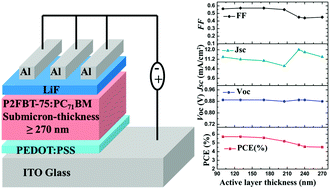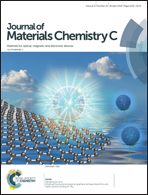Fabrication of benzothiadiazole–benzodithiophene-based random copolymers for efficient thick-film polymer solar cells via a solvent vapor annealing approach†
Abstract
We adopted a ternary copolymerization strategy to construct a series of D–A1–D–A2 random polymers (P2FBT-25, P2FBT-50 and P2FBT-75), utilizing difluorinated benzothiadiazole (2FBT) and alkoxy substituted benzothiadiazole (2ORBT) as complementary acceptor units and thienyl-substituted benzo[1,2-b:4,5-b′]dithiophene (BDT) as the donor unit. By changing the molar ratio of the two acceptor units, the optical, electrochemical, and charge transport properties can be tuned. The optimal ratio of 75 : 25 between 2FBT and 2ORBT in the random terpolymers enhanced the efficiency of the P2FBT-75:PC71BM blend via a CHCl3 solution vapor annealing approach, exhibiting an efficiency of 5.72% due to improved light absorption and balanced charge transport. Moreover, an efficiency of over 5.60% can be obtained with an active layer thickness of 100–170 nm, and the PCE of over 4.52% was observed even though the thickness was around 270 nm. Noticeably, the three random copolymers that differ considerably in composition, all afford high PCEs (5.00% for P2FBT-25, 4.40% for P2FBT-50, and 5.72% for P2FBT-75), suggesting that high performance materials can be developed within a reasonable composition range via random copolymerization.



 Please wait while we load your content...
Please wait while we load your content...